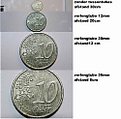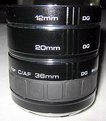
Chris Lauritzen
(K=14949) - Comment Date 10/28/2003
|
Zooms do not work when reversed. Your best choice is a 50mm prime lens. You need to get a reversing ring that will fit your camera mount and has the filter thread size that your lens has. If you have a af camera your AF will not work and metering will to totaly manual.
|
|
|
|

John Bohner
 (K=8368) - Comment Date 10/28/2003
(K=8368) - Comment Date 10/28/2003
|
I had good luck doing this with an old nikon and a 24 mm wide angle as well. The adapter did screw into the filter ring thread and then mounted the lens backwards on the camera. I seem to remember that wide angles give more magnification than normal lenses but I've forgotten the reason/formula. Caution - doing this puts the rear lens element out in front of the camera with no protection and a damaged rear element is much worse than a damage front element.
|
|
|
|

Elangovan S
(K=10675) - Comment Date 10/28/2003
|
Check out this incredible site and article. http://www.mplonsky.com/photo/article.htm#rev
http://www.usefilm.com/photographer/17431.html
Elangs.
|
|
|
|

Scott McFadden
(K=5663) - Comment Date 10/29/2003
|
Umm sorry chris
despite the respect and value your comments have for me there are times when we all make mistakes.
I believe what he meant to say is zooms arent as good at it.
reversing adapters are hard to find though a easier find may be to get a m42 adapter for your camera then glue a 49mm cokin to a cokin your lens size is.
also be very aware of johns warning.
|
|
|
|

Kurt Pas
(K=2267) - Comment Date 10/29/2003
|
Thanks for the explanation.
Still one thing is not fully clear. Do you mount the lens reverse to the one sitting on the slr (if you glue to filter rings together), or do you mount the lens in reverse directly to the camera body.
If it is the first situation, on witch lens to control aperture and focus
|
|
|
|

Chris Lauritzen
(K=14949) - Comment Date 10/29/2003
|
I don?t believe I gave any incorrect information but maybe for once I was wrong...lol When I have tried zooms reversed they don't work all that great...
If you reverse a lens what you create is basically a good macro lens. As I said when I tried zoom lenses they have not worked well at all and I went with a 50mm prime, which I also use as a part time loupe.
You can get reversing adapters for just about any mount out there. I have seen adapters for Nikon, Canon FD and EOS, Minolta, Pentax...etc so it should not be hard to find one for your camera. Checkout Porters camera at www.porters.com.
|
|
|
|

Chris Lauritzen
(K=14949) - Comment Date 10/29/2003
|
You mount the lens to the reversing ring then mount the ring to the camera. The lens is mounted to the camera reversed i.e. the part that normally would be inside the camera is now in front. Yes all the control is lost but your camera should still give you the meter reading and then you can manually set the aperture and shutter.
|
|
|
|

Robert Stokes
(K=4509) - Comment Date 10/30/2003
|
Until recently I did not know about any adapter for this technique, so I have just been holding a 50mm lens backwards against the mount. I have had some success doing it this way but you have to be very steady, with or without a tripod. Give it a try.
|
|
|
|

Kurt Pas
(K=2267) - Comment Date 10/30/2003
|
Hey Robert! (Sorry, off topic)
It look like we share the same passion (took a look at your portfolio)! I'am a climber too. I live in belgium, europe. But years ago I have lived for 6 mounts in Jackson Tennessee (Project for P&G- Pringles).
When I was overthere I did some climbing on "Mouse Tail Landing Park" and "Fall Creek Falls".
The belay was either toproping on a tree or putting my own protection. I did not find equiped climbing spots that time.
Here is a climb pic of me : http://www.belclimb.net/gallery.php?mode=getPicture&cat=alpi&id=27
kpas@toptech.com
|
|
|
|

Robert Stokes
(K=4509) - Comment Date 11/1/2003
|
My internet connection is acting weird tonight, wouldn't load the photo. I'll try again later. We have some very nice trad climbing around here, in western North Carolina. The area is called Linville Gorge, with the best place being Table Rock. Several 4-5 pitch moderate climbs ( 5.6 to 5.10 ). Fall Creek Falls is about a 2 hour drive from where I live but I have never climbed there. Nice to hear from a fellow climber/photographer.
|
|
|
|

Domjan Svilkovic
(K=3104) - Comment Date 1/13/2005
|
People with small digicams (Canon A series is very good at this) can build their own plastic adapters and mount 50mm lens. It is really not that hard and can get pretty decent macro.
Take a look at my macro pictures (one new added every day).
|
|
|
|

Patrick Ziegler
(K=21797) - Comment Date 2/22/2005
|
Kurt
I made extension tube. this moves the lens further away from the camera and give the same effect as reversing the lens. Teir may be some optical differences but my results so far have been good.
I used a body cap and a rear lens cap and a rubber 2 inch to 2 inch sewer line coupler. I cut out the centers of both cap and attached them to the coupler so that I could mount a lens at one end and the other end mounts to the camera body. This mounts my 35-80mm lens about 2.5 inches further away from the camera.
Reverse mounting may have merrits but you putting the rear element of your lens in harms way. If you scratch it or otherwise damage it, the cost of repair may be more than replacing it. DAmge to the rear element will leave noticable defects in your photos.
My set up cost less than $5.00 to make. I wish I had some stunning insect shots to share but I have only just put this together. It's winter here and insects a very few and far between.
Here are a few test shots.
http://www.usefilm.com/image/704170.html
http://www.usefilm.com/image/703001.html
http://www.usefilm.com/image/697864.html
More to come
|
|
|
|

Peter Houtmeyers
(K=3519) - Comment Date 2/22/2005
|
Dag Kurt.
Volgens my heeft Pat volledig gelijk wanneer hij zegt dat verlengbuizen (extension tubes) eigelijk een betere oplossing bieden. Een lens omgekeerd monteren heeft een pak nadelige gevolgen. 1.de omgekeerde lens is volledig onbeschermt(er kan langs deze kant veel stof de lens binnendringen,de contaktpunten kunnen beschadigd raken).2 de twee lensoppervlakken staan nu met hun bolle kant tegen elkaar(in het slechtste geval krassen op de beide lenzen)3.De focusafstand tot aan het onderwerp is zeer klein( 4o tot 60mm max)4. twee lenzen betekend ook twee keer zoveel lagen glas( veel glas= slechte kwaliteit foto's) 5.sterk verminderde lichtinval , dus tragere sluitertijden en dus ook veel bewegingsonscherpte. speciale koppeladapters zijn moeilijk te vinden en twee aan elkaar plakken gaat u vroeger of later wel eens zuur opbreken wanneer deze lijm besluit te lossen! Als je graag wat meer uitleg had gehad over het gebruik van extension tubes ......EMAIL phav@skynet.be
|
|

|
|

Kurt Pas
(K=2267) - Comment Date 3/4/2005
|
Bedankt Peter,
Ik zal eens kijken wat een extention tube voor een Nikon lens kost.
Moet je dan niet volledig manueel fotografren? Of stuurt de tube het diafragma en de AF motor van naar de lens door?
Oerigens, erg mooie foto's die je maakt!!!
|
|
|
|

Peter Houtmeyers
(K=3519) - Comment Date 3/4/2005
|
Dag!
Autofocus werkt niet meer maar uw diafragma wel.
Het gebruik van autofocus met macrofotografie is eigelijk wel af te raden omdat de scherpte- diepte( depht of field,"DOF")heel gering is. Het is beter om manueel scherp te stellen op datgene dat je scherp wil.Er is ook een gering lichtverlies als je de buizen(tubes) als een set wil gebruiken( ong 1/4 stop).Je kan deze buizen wel op elke lens gebruiken, zowel op een 50,100,200mm enz...maar dan word de focusafstand beperkter. Daarmee wil ik eigelijk zeggen dat je zonder deze buizen kan scherpstellen tot op oneindig met b.v een 200mm lens.....maar als je met deze buizen werkt b.v nog tot op 10,15meter. Het is ook goedkoper als je ze als setje van drie besteld. De mijne zijn van soligor maar tamron en kenko maken ze ook. Er zullen er ook wel van nikon bestaan maar deze zijn dan ook dubbel zo duur. Bij Foto-Konijnenberg in nederland kosten die van soligor 125 euro voor de complete set voor Nikon.
Peter
|
|

|
|

Joe Johnson
 (K=8529) - Comment Date 3/26/2005
(K=8529) - Comment Date 3/26/2005
|
Mount a reverse lens?
B & H have 'macro couplers'. These are threaded on the outside on both sides (camerafilters.com is a NYC storefront that has a more limited range). And they are not necessarily the same diameter. If you have a 55mm thread on the front of a lens, and a 52mm on your camera, there are 55mm-52mm 'macro couplers'.
As for which lens, people like the 'Rokker-X' MD mount Minolta lenses, but particularly because the iris stays open before shooting, which is what you want if you're turning the lenses around. They have 1:1.4 bright 50mm lenses on ebay quite frequently, generally for very little money. It's a good one. If you find a 1:1.2, it should open even wider, but will cost much more. These tend to have 55mm front threads. Another way, is simply to put tape over the front lens threads and slip fit the lens over whatever tube extension is used, if we're talking a digicam. That would get it even closer.
Because the problem with this approach is that if you only have say a 3x optical zoom, you'll get a 'cameo' black ring on the edges - vignetting. If you have a camera with greater zoom, it might not be a problem. You can turn the focus ring to get larger macros or smaller. But the smaller might be preferable, since you can hold the camera a half an inch further away from the subject, if it's an insect say. Obviously, the other problem is that you're exposing the 'inside' part of the lens to the elements, without any way to fasten on a UV protective cover. But since you're dealing with such small distances to the subject, you might not have room for a protective lens. If you wanted, you might remove the tang and rig up something that screws in or just crazy glue some step down rings for a filter on the back. But again, you might not have room. You're shooting at very close distances.
|
|
|
|

Jeroen Wenting
 (K=25317) - Comment Date 3/26/2005
(K=25317) - Comment Date 3/26/2005
|
Kurt, Peter. It would be better to converse in English as that way everyone benefits.
As to extension tubes, there are tubes that do maintain electronic and mechanical coupling between lens and camera (thus metering, aperture, and possibly AF).
These of course cost more than the cheap ones that don't have the linkage incorporated.
Some time ago I converted a cheap crappy teleconverter to an extension ring for my old Minolta camera (which has only mechanical linkage for the aperture). It works like a charm, and can be cheaper than buyin dedicated extension tubes. Just remove all the optics from the teleconverter and give it a try (the optical path through the ring you get this way is probably quite narrow though, limiting the choice of lenses you can mount on it).
|
|
|
|
















